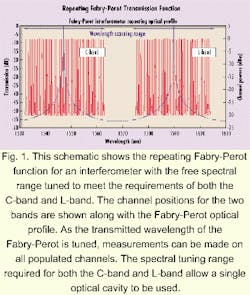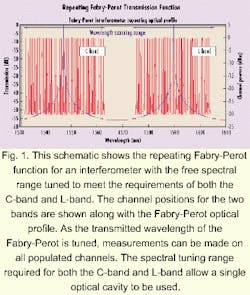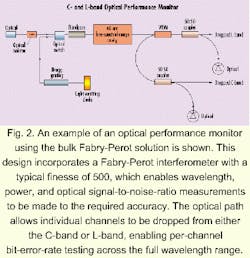C- and L-band channel monitoring
With the advent of L-band optical amplifiers, optical performance monitors must provide per-channel measurements over extended wavelength regions.
Over the last few years, dense wavelength-division multiplexing (DWDM) has been widely adopted across the telecommunications in dustry to expand capacity in transmission systems. Increasing bandwidth demand has been met with the adoption of DWDM systems that offer 50-GHz channel spacing in the conventional- (C-) band, but this solution is reaching its limitations. Further increases in capacity are being realized by system operation in the C-band and the long- (L-) band simultaneously. This dual-band operation is now possible because of the recent development of L-band optical amplifiers and associated technologies.
The advances with L-band optical amplifiers, however, are providing significant challenges to the optical performance-monitoring function in DWDM systems. Optical performance monitoring in the optical layer is a critical component of the network management of DWDM systems. With the advent of L-band optical amplifiers, optical performance monitors must provide per-channel measurements of wavelength, power, and optical signal-to-noise ratio (OSNR) over both the C- and L-band regions.
The move to C- and L-band operation increases DWDM transmission capability by at least doubling the number of channels present in a single optical fiber. Optical monitors, therefore, need the ability to measure up to 256 channels simultaneously in both wavelength regions. The increased number of channels heightens the possibility of per-channel errors, which have massive associated financial implications.
The fundamental parameters measured by optical channel monitors on a per-channel basis are wavelength, power, and OSNR. With 50-GHz-spaced systems, wavelength accuracy of 50 pm is required with a power-measurement accuracy of 0.5 dB. OSNR capabilities of up to 30 dB with an accuracy of 0.5 dB are desirable with individual channel input powers from -10 to -55 dBm over all states of polarization. This arrangement allows monitors to be used at various points throughout transmission systems, both pre- and post-amplifier. Based on these fundamental measurements, analysis of the gain and gain tilt of an optical amplifier can be made to monitor amplifier performance in both the C-band and L-band. All of that must be achieved without degrading the transmitted data.
Performance monitors operating in both bands simultaneously must cover a wavelength range from 1500 to 1630 nm. Optical channels are concentrated in the C-band around 1530 to 1563 nm and in the L-band around 1575 to 1610 nm. Associated supervisory channels as well as unused channels on the International Telecommunication Union (ITU) grid are spread throughout the rest of the wavelength range.
As with current C-band optical performance monitors, C- and L-band performance monitors must be compact and reliable. The real estate available in DWDM systems for embedded optical monitors is small. Ideally, monitors will fit into existing mechanical footprints and not require a redesign of the performance-monitoring cards. Similarly, the electrical interfacing and communication structures should fit into existing system architectures. Thus, optical monitoring solutions that use just one monitor for both the C- and L-band simultaneously meet the mechanical and interfacing requirements. Monitors used as embedded test equipment also need to meet the stringent environmental conditions-operating temperatures from 0° to 70°C and relative humidity from 5% to 95%.
A number of technologies can be used to address C- and L-band monitoring--conventional diffraction grating optical spectrum analyzers (OSAs), in-fiber-grating-based systems with array detectors, and Fabry-Perot-based optical performance monitors.
The major difficulty with traditional diffraction-grating-based OSAs is the size of the unit required to achieve the optical measurements. Embedded solutions require performance monitors, which can be rack-mounted in system racks on individual monitoring cards.
The in-fiber-grating-based solution with array detectors currently provides performance monitoring in the C-band using a 256-element-detector array to obtain the required level of wavelength resolution with the use of post processing techniques. To move to an extended wavelength range involves using a 512-element-detector array or greater. This approach presents technology and manufacturing challenges and has an associated cost penalty. Moreover, achieving simultaneous C- and L-band measurements with this approach is likely to require an increase in the size of the performance monitor.
The existing technology best suited to provide simultaneous C- and L-band monitoring is the Fabry-Perot-based interferometer. The main advantage to using this technology is that a single monitor addresses both wavelength bands simultaneously. This monitor is obtained using a single interferometer (or optical head) that is identical in mechanical footprint to current C-band monitors. Therefore, monitors based on this design can be implemented with current DWDM systems. It also allows C- and L-band optical monitors to be mounted on existing monitoring cards with little or no redesign of the monitoring circuit packs. C-band performance monitors based on this design are widely used across the telecommunications industry in both embedded and test and measurement applications.
In Fabry-Perot technology, a major characteristic is the repeating transmission window as a function of wavelength. The size of this window is governed by the free spectral range (FSR) of the Fabry-Perot cavity, which forms the wavelength tuning mechanism in this performance-monitor design.
The Fabry-Perot FSR requirements are governed by the spectral range of the optical-channel plan in the respective band. These spectral ranges allow Fabry-Perot interferometers with the same FSR to be used in monitors to interrogate channels in the C-band and L-band individually.
Together with the properties of the repeating Fabry-Perot function and the FSR requirements for the Fabry-Perot cavity, the same Fabry-Perot cavity can be used to interrogate both C- and L-band optical channels simultaneously. The optical coating of the Fabry-Perot interferometer must cover both C- and L-band wavelengths, operating from 1500 to 1630 nm. These coatings are readily available.
Therefore, it's possible to obtain a single optical performance monitor using the bulk Fabry-Perot technology that operates in both the C- and L-bands simultaneously, with only minor changes to the optical-coating requirements and no changes to the bulk optical design of the wavelength tuning mechanism. Future monitors using the current interferometer design and the same mechanical footprint, can be implemented with the addition of a few commercially available passive optical components.An example of an optical performance monitor using the bulk Fabry-Perot solution is shown in Figure 2. This design incorporates a Fabry-Perot interferometer with a typical finesse of 500, which enables wavelength, power, and OSNR measurements to be made to the required accuracy.
A further advantage of this technology is also demonstrated in Figure 2 with the addition of a drop-channel optical path. The optical path allows individual channels to be dropped from either the C-band or L-band; it enables per-channel bit-error-rate (BER) testing across the full wavelength range. The ability to perform per-channel BER testing allows for increased levels of signal analysis on transmitted data.
By using this existing, well-developed technology, the benefits of this bulk Fabry-Perot design over fiber Fabry-Perot's, including size, vibration, and environmental ruggedness, are transferred to future monitors. The bulk optical design and control allows linear wavelength-performance monitoring over both bands, and therefore over the complete wavelength range needed to meet the C- and L-band monitoring requirements.
This solution offers cost reduction through the use of a single monitor to interrogate both wavelength regions and size reduction through the use of a single monitor with a mechanical footprint that is similar to that of existing performance monitors. Time-to-market is another advantage. This solution uses existing technology, which can be implemented quickly to meet the aggressive timetables of increased bandwidth DWDM systems.
To address the needs of DWDM transmission systems in the near future, it is essential that optical performance monitors meet the criteria previously discussed.
The chosen technology will be that which provides the easiest, most cost-effective route to monitoring both the C-band and L-band simultaneously.
Moreover, optical performance monitoring throughout the optical network at all levels is required. As DWDM becomes more and more cost competitive, it is moving beyond the long-distance networks into applications in the metropolitan, interoffice, and access markets. A technology solution that can meet optical performance-monitoring requirements, while minimizing the design changes to DWDM circuit packs and rack systems offers a major advantage to end users and service and system providers.
A single embedded unit will ultimately bring value-enhancing efficiencies, both economically and technically, which are unattainable with singleband devices.
Adrian Meldrum is the business development manager for Queensgate Instruments Ltd. (Bracknell, England).


